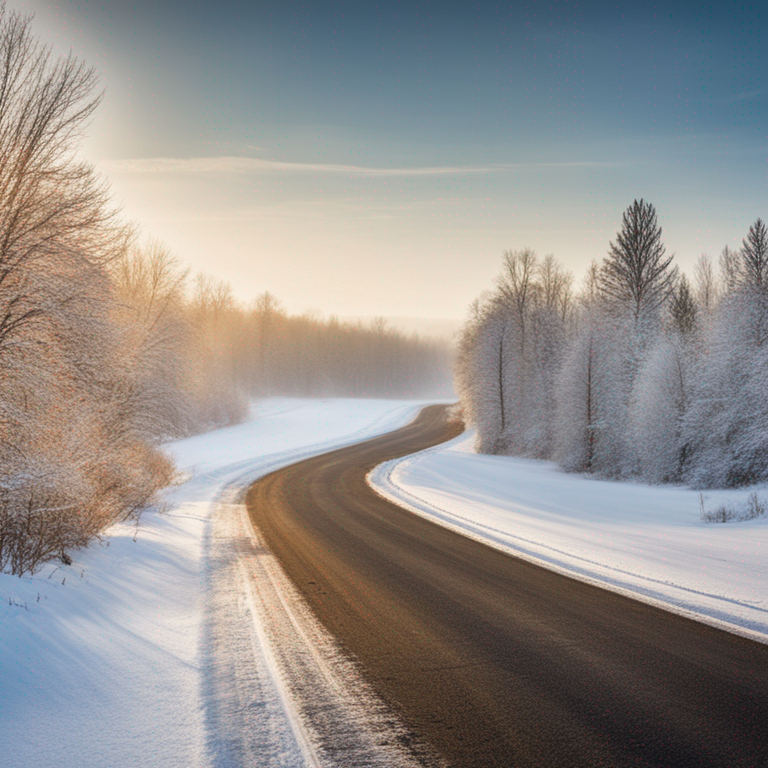I would love to know what the actual blocker to immediate global rollout [of robot cars] is.
In a word, snow.
I can’t help but feel it telling that all of the self-driving car trials take place in sunny places like LA and Phoenix. Snow, as I see it, creates two large obstacles for self-driving cars: the snow can physically obscure the road, and the snow (and ice) will differentially change the road surface friction.
An Obscured Road Surface
Even if you’ve never had the pleasure to have driven in snowy conditions, it seem is easy to understand that as snow falls, it will cover the road surface and the markings on it. If you self-driving car is using a camera to “stay between the lines”, they all of sudden need a different lane marker. Adding to this, human drivers don’t always drive in the official “lanes” when the snow falls; in the extreme, drivers on rural roads will generate only three tire tracks, effectively using the center one when driving both ways down the road, and then pulling over to the side (out of the tire tracks altogether) to pass on-coming traffic.
One of my most stressful personal drives I’ve ever done was when the snow completely covered the road surface and the surrounding fields were snow-covered and at the same height as the road. Without any previous tracks to follow, I drove two hours in the dark (with headlights only) keeping a 3 inch bump in the snow off to my right that I knew was the taller grass at the pavement edge. There was no place to turn off, no shoulder, and I was worried that if I stopped in the driving lane in the middle of the continuing snow storm, someone would come up from behind and crash into me before they saw me. All to say, not an enjoyable drive, and a very hard situation to expect a self-driving car to perform well in.
An Icy Road Surface
Perhaps less obvious if you’ve never driven in winter conditions is how (snow and) ice change the response of the road surface itself. In perhaps the simplest to understand situations, a layer of ice on the road (like after freezing rain) will make the road itself slick, and so more distance is needed to accelerate, break, and change direction. But more typical is that the changing patterns of sunlight (and shadow), applied road salt, blowing snow, and the passing of vehicles will create a patchwork of more and less icy patches. A few examples:
- bridges tend to ice over before the rest of the roadway as temperatures drop, as they lack the ground under them as a heat store.
- as vehicles wait at the stop line of traffic light for the light to turn green, the heat from the engines will melt the ice on the road under them. As a result, the road is much slicker right before the stop line than elsewhere. Thus, you can’t count on stopping at the stop line, and instead slow down much before the intersection, and only do the last bit of breaking at the stop line.
- as vehicles drive down the road, they clear out snow under the tire pathes, but build up the snow in ridges beyond these ruts. Thus, when the vehicle moves sideways, such as to change lanes, the car will meet more resistance outside the normal running ruts. In extreme cases, in front wheel drive vehicles and heavy, slushy snow, if you accelerate as you hit this ridge, the wheel in the ridge will be mostly held by the extra snow while the “free” wheel in the driving lane continues to accelerate, and the car will spin!
- in extreme cold situations (i.e. -20°C or colder), as the snow blows across the highway, it will be crushed under the wheels of the passing vehicles, causing it to momentarily thaw and then re-freeze. Thus, wind-blown sections of the highway can busy much icier than sheltered sections. And patches of roadside trees and brush will result in repeated changes between windblown and sheltered sections of road, as you drive down a road.
What most of these situations have in common is the best way to deal with them is to anticipate them, rather than waiting for feedback from the vehicle in the middle of the situation.
Conclusions
Much as it would be cool to see self-driving/robot cars, I think it’s easy to underestimate the complexities of winter driving. I would love to “let the car drive” and let it worry about winter conditions, but I’m not holding my breath.
Update (2025-03-14): About the Header Image
The original header image was generated by AI (specifically, Stable Diffusion XL) but I was on a recent roadtrip and so was able to take a “real” photo, which is the current header image!
The original is here below:


Comments
There are no comments yet. Will you add the first one?